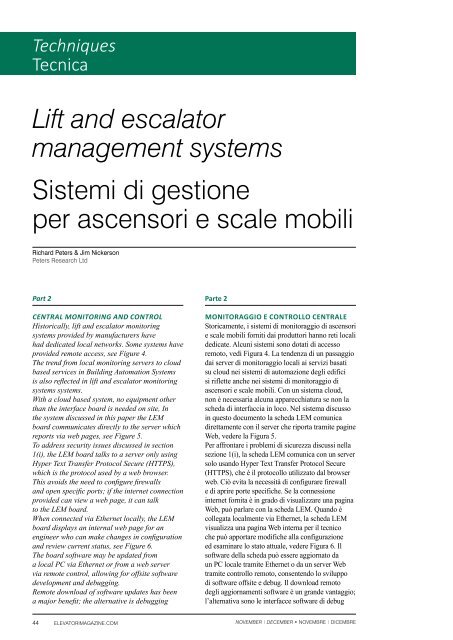You also want an ePaper? Increase the reach of your titles
YUMPU automatically turns print PDFs into web optimized ePapers that Google loves.
Techniques<br />
Tecnica<br />
Lift and escalator<br />
management systems<br />
Sistemi di gestione<br />
per ascensori e scale mobili<br />
Richard Peters & Jim Nickerson<br />
Peters Research Ltd<br />
Part 2<br />
CENTRAL MONITORING AND CONTROL<br />
Historically, lift and escalator monitoring<br />
systems provided by manufacturers have<br />
had dedicated local networks. Some systems have<br />
provided remote access, see Figure 4.<br />
The trend from local monitoring servers to cloud<br />
based services in Building Automation Systems<br />
is also reflected in lift and escalator monitoring<br />
systems systems.<br />
With a cloud based system, no equipment other<br />
than the interface board is needed on site, In<br />
the system discussed in this paper the LEM<br />
board communicates directly to the server which<br />
reports via web pages, see Figure 5.<br />
To address security issues discussed in section<br />
1(i), the LEM board talks to a server only using<br />
Hyper Text Transfer Protocol Secure (HTTPS),<br />
which is the protocol used by a web browser.<br />
This avoids the need to configure firewalls<br />
and open specific ports; if the internet connection<br />
provided can view a web page, it can talk<br />
to the LEM board.<br />
When connected via Ethernet locally, the LEM<br />
board displays an internal web page for an<br />
engineer who can make changes in configuration<br />
and review current status, see Figure 6.<br />
The board software may be updated from<br />
a local PC via Ethernet or from a web server<br />
via remote control, allowing for offsite software<br />
development and debugging.<br />
Remote download of software updates has been<br />
a major benefit; the alternative is debugging<br />
Parte 2<br />
MONITORAGGIO E CONTROLLO CENTRALE<br />
Storicamente, i sistemi di monitoraggio di ascensori<br />
e scale mobili forniti dai produttori hanno reti locali<br />
dedicate. Alcuni sistemi sono dotati di accesso<br />
remoto, vedi Figura 4. La tendenza di un passaggio<br />
dai server di monitoraggio locali ai servizi basati<br />
su cloud nei sistemi di automazione degli edifici<br />
si riflette anche nei sistemi di monitoraggio di<br />
ascensori e scale mobili. Con un sistema cloud,<br />
non è necessaria alcuna apparecchiatura se non la<br />
scheda di interfaccia in loco. Nel sistema discusso<br />
in questo documento la scheda LEM comunica<br />
direttamente con il server che riporta tramite pagine<br />
Web, vedere la Figura 5.<br />
Per affrontare i problemi di sicurezza discussi nella<br />
sezione 1(i), la scheda LEM comunica con un server<br />
solo usando Hyper Text Transfer Protocol Secure<br />
(HTTPS), che è il protocollo utilizzato dal browser<br />
web. Ciò evita la necessità di configurare firewall<br />
e di aprire porte specifiche. Se la connessione<br />
internet fornita è in grado di visualizzare una pagina<br />
Web, può parlare con la scheda LEM. Quando è<br />
collegata localmente via Ethernet, la scheda LEM<br />
visualizza una pagina Web interna per il tecnico<br />
che può apportare modifiche alla configurazione<br />
ed esaminare lo stato attuale, vedere Figura 6. Il<br />
software della scheda può essere aggiornato da<br />
un PC locale tramite Ethernet o da un server Web<br />
tramite controllo remoto, consentendo lo sviluppo<br />
di software offsite e debug. Il download remoto<br />
degli aggiornamenti software è un grande vantaggio;<br />
l’alternativa sono le interfacce software di debug<br />
44 ELEVATORIMAGAZINE.COM NOVEMBER | DECEMBER • NOVEMBRE | DICEMBRE














